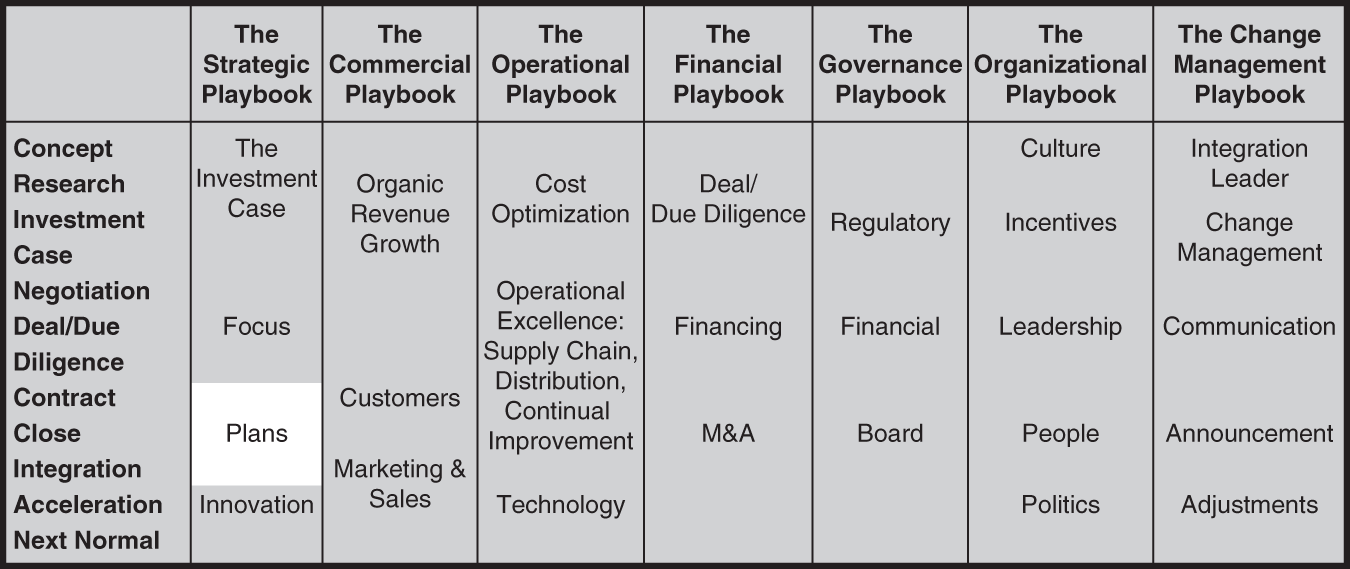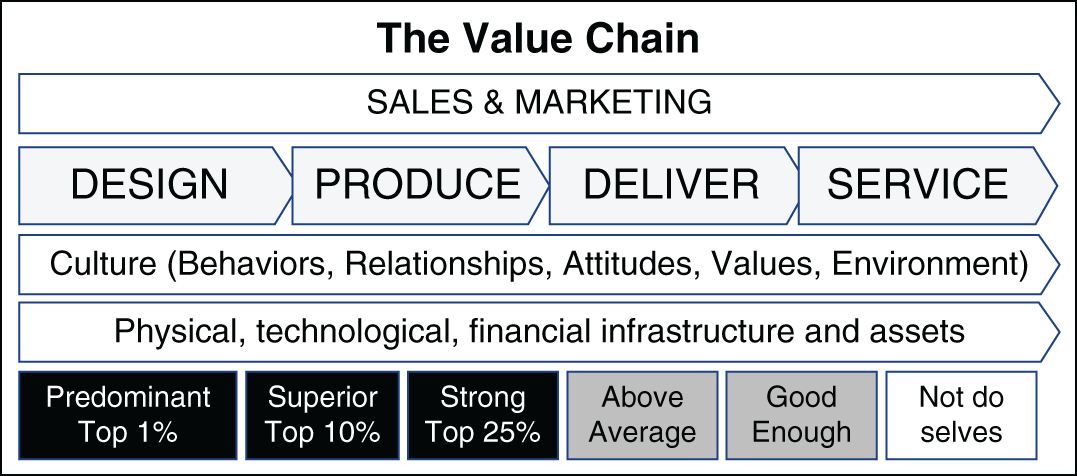CHAPTER 3
Plans: Strategy Precedes Execution

The third component of the strategic playbook is plans. These flow directly from the investment case and focus choices. Let's start by defining the terms:
- Strategy: The single overarching choice
- Strategic priorities, enablers, and capabilities: in line with the strategy
- Culture: The behaviors, relationships, attitudes, values, environment of the organization
Strategic planning is about generating and selecting options to close gaps between objectives and current realities. It is about the creation and allocation of resources to the right place, in the right way, at the right time, over time to overcome barriers and deliver what matters. Strategic planning is also deciding what you will and will not do.

FIGURE 3.1 The Value Chain
Michael Porter suggests that almost any value chain includes design and invention, production, delivery, and customer service and experience in addition to marketing and selling.1 Your single, overarching strategy should identify the right way to build and leverage differentially valuable advantages versus competitors at one of the first four while also marketing and selling—which every organization must do one way or another and is discussed in the commercial playbook (Figure 3.1).
Strategic priorities focus people on the most important areas:
- Hardware and software enablers like systems and processes, infrastructure (data; information technology [IT]; other technology; security; operational including procurement and supply chain; organizational and human resources [HR]; financial reporting, tax, accounting, and compliance; new product development), balance sheet and cash flows (modernization and growth-oriented capital spending, back office) enable delivery of priorities.
- Organizational capabilities across senior leadership (commercial, operations, information technology and other technology, innovation, finance, HR, legal, research and development [R&D], mergers and acquisitions [M&A]), middle management, and individual and team strengths including project management and transformation are those required for the enablers to work.
| Example: | Apple | Coca-Cola | Walmart | Four Seasons |
| Manner: | Proactive | Fast-follow | Coordinated | Responsive |
| Culture: | Independent | Stable | Interdependent | Flexible |
365-Day Plan Elements
The starting point for developing your 365-day plan is your investment case (Chapter 1). Essentially, this is your chance to turn that theoretical construct into real actions to grow the topline and make operational improvements behind investments in enablers.
Do understand you may not be able to get everything done in a year. The bigger and more complex the merger, the longer it's going to take to complete. So just as the things you do in your first 100 days set up what you're going to get done in your first year, some of the things you do in your year 1 set up year 2 deliverables.
- Grow top-line (organically and inorganically).
Gain new customers. Get current customers to buy or pay more.
Classic synergistic revenue enhancers include:
- Cross-selling existing products or services to the formerly separate entities' customers either in the same or new markets
- Getting existing customers to use current products or services in new ways—thereby purchasing more
- Creating and then selling new products or services (that could not have been created without the merger or acquisition)
Establish go-to-market and end customer market pursuit strategies including your marketing, communications, and customer interface; sales model and organization; customer profitability and cash flow cube; end-market analysis and go-to-market strategy; and acquisitions or mergers with other companies, brands, technologies, systems, and the like.
Marketing, Communications, and Customer Interface
- Discuss current mission statement and go-forward strategy.
- Agree on internal and external communication preferences and strategy.
- Enhance website for use as both a marketing tool and current customer tool.
- Assess and build out digital marketing presence.
- Consider establishing customer experience lead (if not already in place).
Sales Model and Organization
- Build out customer relationship management (CRM) focused on pipeline, forecast, customer profitability, and estimates.
- Assess existing sales model and determine if a strategy focused on specific industry verticals or regional or geographically focused model would be more appropriate.
- Determine go-forward customer growth strategy and balance of focus between new customer pursuits and upselling existing customers.
- Determine incremental sales resources required to pursue new customers, expand point of sale and point of purchase service offering, and execute go-to-market strategy.
- Assess current sales commission plan and align with sales targets, organizational strategy, and industry standards.
Customer Profitability and Cash Flow Cube
- Prepare a customer profitability and cash flow cube that quantifies historical contribution margin by customer, product, and end market. Establish the customer profitability cube as a new embedded process within the company.
- Link current customer profitability realization to impending customer renewals to ensure pricing is appropriate.
- Develop a long-term solution for tracking and reporting customer profitability and accurate job costing with a link back to the pricing and estimating process.
End-Market Analysis and Go-to-Market Strategy
- Further analyze existing customer end markets to understand projected growth rates, anticipated demand by product or service offering, market share opportunities for both existing and prospective customers, profitability profiles, and investment required to execute future growth strategies.
- Strategically identify and select new customers’ targets and end markets to pursue.
- Determine future offering strategy and investment required.
- Identify and implement solution for improved front-end customer-facing technology.
Acquisitions or Mergers with other companies, brands, technologies, systems, and the like
- Build business development office plan and develop M&A strategy.
- Increase business development capabilities.
- Create M&A strategy plan including outreach to select targets identified through lender group.
- Identify investment banks and others specializing in industry for potential transactions.
- Build out state of company capabilities and verticals to analyze key areas to target M&A.
- Build out competitive positioning for company.
- Make operational improvements, operational engineering, and product and service innovation.
- Elimination of redundancies
- Operational jump-shifts, perhaps fueled by new technologies or systems, where scope is a function of resources (including levers) and time
- Lean, continuous, and incremental improvements
- Develop a comprehensive, end-to-end production strategy that appropriately links forecasted customer demand with procurement efforts, labor and equipment management, inventory management, freight, and production scheduling. In the interim, remediate immediate staffing, procurement, production scheduling, and freight challenges.
- Chart end-to-end process flow from customer order to delivery and setup. Identify performance gaps and remediation actions.
- Assess current volume forecasting methodology and link to production capacity to develop a near-term, modified approach.
- Conduct fulsome supplier review to identify improvements with regards to pricing, potential consolidation of duplicate suppliers, terms, payment methods, lead time, and so forth.
- Assess overall production reporting including use of metrics and automation. As required, develop production metrics and daily, weekly, and monthly key performance indicators (KPIs) to monitor performance and improve production efficiency.
- Assess structural engineering capabilities and potential needs.
- Assess potential product and service innovations.
- Invest in top-line and bottom-line enablers.
- Putting in place a full management team capable of managing another doubling of revenue for the next owner
- Recruit for open C-suite, board, and business development positions.
- Establish delegation of authority protocol, decision-making, and governance structure.
- Provide executive onboarding support and training.
- Monitor employee safety, customer demand changes, and other changes.
- Strengthening governance
- Form board, audit, compensation, and technology committees.
- Instilling financial engineering or cash management
- Finalize operating plan, 5-year reforecast, and capital plan.
- Create capital planning function to include IT investments, equipment, and other capabilities.
- Set management equity, debt/leverage, board participation.
- Set compensation structures.
- Establishing the required infrastructure
- For organizations focused on design, this might look like a new product development factory;
- For organizations focused on production, this might look like efficient procurement and manufacturing machines;
- For organizations focused on delivery, this might look like a distribution network or ecosystem;
- For organizations focused on service, this might look like service-delivery and experience differentiators;
- All supported by IT systems including enterprise management and business intelligence, CRM.
- Identify vendor to conduct a cybersecurity full review—critical in today's age; implement recommended security changes.
- Review cloud disaster recovery and business continuity planning remediation.
- Conduct Microsoft and other relevant license audits to ensure compliance and optimize or lower license count where feasible.
- Commence IT organization leadership assessment and search in conjunction with executive team.
- Build data warehouse to use as workflow management tool within the sales organization.
- Putting in place a full management team capable of managing another doubling of revenue for the next owner
Financial Reporting Systems
Financial Planning and Analysis (FP&A) and Accounting
- Review and potentially supplement monthly and quarterly operating review packages to ensure reporting framework is consistent across locations.
- Review daily and weekly financial and operational KPI tracking and reporting and discuss other items to include.
- Review existing internal control environment and discuss process to address deficiencies identified by external auditors.
- Finalize the opening balance sheet and purchase accounting.
- Stand up forecasting capabilities and establish rigorous 5-year forecast.
- Review future organizational staffing plan.
- Review current working capital management and assess for possible improvements (to include customer credit review).
- Build robust month-end close process and calendar to ensure timely and efficient month-end reporting.
Treasury
- Review daily cash reporting process, output, and overall cash management setup and strategy.
- Review 13-week cash flow reporting process and output.
- Review and potentially enhance existing lender reporting process.
- Explore setting up new revolver loan and asset-based lending (ABL) to provide additional liquidity.
- Review disbursement process for potential improvements and efficiencies.
Tax
- Conduct tax and structure planning for the new company.
- Create quarterly shareholder reporting distribution cadence and audience.
- Update payroll reporting.
- Review purchase price allocation as related to fund management and the go-forward balance sheet.
Insurance
- Review all insurance programs with the company and its broker to determine if there are any updates or changes needed after the transaction has closed. This review will include re-benchmarking all limits and coverages under all current insurance policies.
- Provide any information required to complete the underwriting and issuance of the insurance policies to have in place at the closing.
Compliance
- Create compliance program.
Human Resources (HR) Management Systems
- Create and roll out management equity incentive plan including documentation and communication.
- Continue work on retention strategies and organizational design.
- Support recruiting and placement of senior leadership.
- Assess and support general HR function, as needed.
- Review company organizational structure and chart and assess for future needs.
- Set up new employee agreements.
- Review current employee benefits package.
The most up-to-date, full, editable versions of all tools are downloadable at primegenesis.com/tools.
Note
- 1 Porter, Michael E., 1985, Competitive Advantage: Creating and Sustaining Superior Performance (New York: Simon and Schuster).
